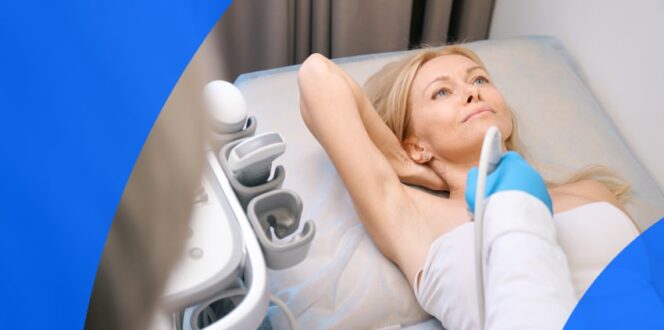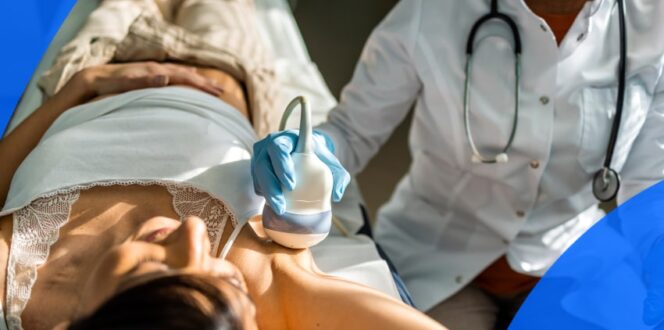What to Know About Mammogram Scans and Breast Cancer

Regular mammogram scans provide important information about your breast health and enable earlier breast cancer detection, improving recovery rates.
A mammogram scan is a valuable tool to assess your breast health. Mammograms are typically ordered for 2 reasons: screening mammograms proactively scan for any breast abnormalities, whereas, diagnostic mammograms diagnose those experiencing concerning symptoms, such as a breast lump.
Finding breast cancer early is critical to the effective treatment of the disease, and regular mammogram screening can help alert your doctor to new changes in breast tissue. Draft 2023 mammogram guidelines issued by the U.S. Preventive Services Task Force (USPSTF) suggest that a woman at average risk of breast cancer should receive a mammogram scan every 2 years beginning at 40 years old. In Canada, the starting age for screening without a referral depends on which province or territory you live in.
Some women may be at greater risk and may need to have mammogram scans more often. Your doctor may send you for a mammogram as young as 30 years old if you are a carrier of the BRCA1 or BRCA2 gene or have had radiation to your chest since these factors increase your lifetime risk of developing breast cancer. In these high-risk populations, breast MRI is also recommended for screening.
If it’s time for your mammogram scan you may have questions about the appointment, including:
- How does a mammogram work?
- How can I prepare for my appointment?
- How do I understand my mammogram results?
Understanding how mammograms work and how regular screening benefits you helps you stay on top of your health and have more informed discussions with your physician about the results.
What’s a mammogram?
A mammogram is an X-ray that allows your healthcare team to assess the tissue of your breast for irregularities, including masses. Mammograms help your doctor investigate any abnormalities like lumps you may feel while doing a breast self-exam, but they can also catch masses too small for you to feel.
Mammogram scans use X-ray technology to examine breast tissue. While patients are exposed to very small amounts of ionizing radiation during a mammogram, the benefits of catching breast cancer early outweigh the radiation exposure in the screening population. If you have concerns about the impact of the radiation from a mammogram, speak with your doctor to better understand the risks of the procedure.
There are different types of mammogram scans, such as:
- Film screen: images of breast tissue are captured on film, viewed on a lightbox or scanned into a digital format.
- Digital mammography: images of breast tissue are captured onto a digital detector, allowing your doctor to see different views of the breast digitally.
- Digital breast tomosynthesis: also called a 3D mammogram scan, the screening uses X-rays to create three-dimensional images of the breast.
After your mammogram scan, the mammography technician will send the images of your screening to a radiologist. A radiologist is a doctor who specializes in diagnosing and treating injuries and diseases using medical imaging. Once a radiologist has assessed your mammogram scan, they will send the report to your doctor, who will schedule an appointment to discuss any results.
It’s critical that your radiologist has access to all available images before providing an opinion on a mammogram scan. A lack of available prior images—which may have been obtained at a different medical imaging facility—can lead to missed cancer or unnecessary procedures.
As a patient, you can use PocketHealth to access any prior mammogram results from other sites and have the option to share those historical results so that the radiologist has access to all prior scans when reviewing your recent mammogram results. Access your records here.
How often should you have a mammogram?
Regular scans can reduce the risk of serious outcomes from breast cancer. The USPSTF breast cancer screening guidelines for 2023 recommend that women with average breast density should get regular mammogram scans from ages 40 to 74. In Canada, women between the ages 50 and 74 can self-refer for a mammogram every 2 years, but some provinces and territories, like British Columbia, start screening as early as age 40.
Breast tissue density is an important factor when considering breast cancer risk and screening. A mammogram can show the radiologist how much fibroglandular breast tissue is in your breasts. Women with very dense breasts, containing a lot of fibroglandular tissue (>75% dense tissue or category D), have an increased risk of developing breast cancer and should receive regular mammogram scans. Dense breast tissue can make mammogram scans less effective, so speak to your doctor if you’re concerned you may fall into this category.
For more information on dense breast cancer screening in Canada and the U.S., check out this article.
What does a mammogram scan for?
Data from the American Cancer Society and the Canadian Cancer Society shows that, besides skin cancer, breast cancer is the most commonly diagnosed cancer among women. If you have no signs or symptoms of breast disease during screening, the USPSTF recommends a mammogram every two years for all women at average risk of breast cancer between the ages of 40 and 74 years of age.
If you have signs or symptoms of breast disease (such as a new lump or bloody nipple discharge), you should undergo a diagnostic workup which often includes mammography. You should not wait for a regular screening mammogram in this situation.
When it comes to screening, some risk factors might mean your physician recommends you have mammogram scans more often or that screening must also be performed with a breast MRI. Your doctor may send you for a mammogram as young as 30 years old if you are a carrier of the BRCA1 or BRCA 2 gene or have had radiation therapy to your chest since both factors increase your risk of developing breast cancer, but other risk factors can change how often you have a scan.
Speak to your doctor if you believe you’re at increased risk of breast cancer. For example, high-risk screening often also includes a breast MRI.
Other reasons you should talk to your doctor about a mammogram scan include:
- Age: the U.S. guidelines suggest getting biannual mammogram scans between 40 and 74 years of age. If you are under 40, your doctor may send you for a mammogram if you have breast cancer risk factors.
- Family history of breast cancer: having a first-degree family member (e.g., mother, daughter, or sister) with breast cancer increases your risk, too.
- Other risk factors: certain risk factors make you more likely to develop breast cancer. These risk factors include carrying the BRCA1 or BRCA2 genes or receiving chest radiation.
- Nipple discharge: discharge is sometimes associated with abnormal tissue formation or tumor growth in the breasts, especially if this discharge is clear or bloody. A mammogram scan—often combined with a breast ultrasound—can help to determine whether or not nipple discharge is breast cancer-related.
- Lumps in the breast: breast lumps can be benign or malignant (i.e., cancerous). If you or your doctor has noticed a lump during a physical exam, a mammogram can uncover more details about the growth. This is often accompanied by a breast ultrasound.
- New or worsening pain or discomfort: you should discuss any change in breast health with your doctor, including pain or discomfort. While breast pain is usually normal and most of the time tumors are painless, occasionally tumors can cause breast discomfort or pain.
Can a mammogram identify cancer?
A mammogram scan is effective at screening for breast cancer because it allows the radiologist to see very small abnormalities in breast tissue, even those too small to feel with a physical exam. Mammogram scans allow malignant abnormalities to be detected early, increasing the effectiveness of cancer treatment.
Early detection with mammography improves breast cancer survival. Research in 2020 shows that women who participate in breast cancer screening are up to 41% less likely to die over the ten years following detection.
Although regular mammogram screening can make treatment more effective because cancer is caught early, mammograms also have limitations. Some cancers cannot be detected on a mammogram because of the nature or location of the cancer, or the density of breast tissue. Mammograms can also lead to unnecessary anxiety, inconvenience and additional procedures: most screening mammograms that are interpreted as abnormal turn out to be normal tissue or benign disease after further imaging or breast biopsy.
What are false-positive and false-negative results?
No test is perfect. The baseline risk of cancer in the screening-eligible population is about 5 in 1000, increasing with age or other risk factors. Like all tests, mammograms can give false-positive or false-negative results, meaning the images do not accurately represent what’s happening in your body.
With a false-negative result, a mammogram indicates that there are no concerning irregularities in your breast tissue—when there may actually be some concerning abnormalities. The National Cancer Institute states that mammograms can miss cancer that is present at the time of the scan and give false-negative results about 20% of the time.
On the flip side, a false-positive result indicates there is an area of concern on the mammogram when there isn’t one actually present in your breast. Research indicates that false-positive results happen in about 12% of screening mammography scans.
False-positive and false-negative mammogram results can cause a lot of stress to the patient and lead to unnecessary testing or, in some cases, can cause cancerous results to be missed.
How to prepare for a mammogram
A mammogram is an integral part of breast cancer screening and requires only a short appointment, but there are some steps you can take to prepare in advance for your scan:
- Obtain any prior mammogram imaging. Having the radiologist compare your current mammogram to any priors is critical to avoid false positive or negative results. Speak with your doctor to get imaging from previous mammogram clinics so that you can bring the imaging to your new appointment or request that your doctor send the imaging to the clinic before your appointment. PocketHealth can help you keep your medical imaging securely organized together, so you can bring them to your appointments yourself or share them at referral appointments. Having all your mammogram imaging in one place lets you easily monitor different imaging results over time.
- Bring your requisition form. You’ll be asked for your requisition form when you arrive for your appointment and having it ready and accessible makes checking in for your appointment quicker.
- Use the same clinic. If possible, try to get your mammogram screenings done at the same clinic each time. This can make it easier to compare imaging. If you’re unable to do this, give the mammogram clinic the names and addresses of the clinics where you’ve had mammograms and the dates.
- Schedule your appointment when your breasts aren’t tender. Your breasts may feel sensitive leading up to or during your menstrual cycle, so avoid making your mammogram appointment during these times. Often, breasts are most tender the 7-10 days before your period.
- Avoid deodorant or antiperspirant, as well as lotions. Don’t apply deodorant or antiperspirant on the day of your mammogram appointment, and make sure to wipe off any deodorant residue since the mammogram can pick up the aluminum. Also, avoid using lotions or creams on your breast or the surrounding area that day. You may wish to pack deodorant or antiperspirant to apply after your exam.
- Remove long earrings or necklaces. It’s best to avoid wearing jewelry to your appointment because the metal can interfere with the image.
- Wear a top and bottom, rather than a dress. You will be asked to remove your top and bra during your mammogram, so wearing pants or a skirt may make you more comfortable during your appointment.
- Reduce caffeine intake. Caffeine can make breast tissue more tender, so try to avoid—or limit—caffeine intake for 4-5 days before your appointment.
- Let the clinic know if you have implants. Breast implants require modifications to the mammogram process, so your appointment may take longer. Also let the technologist know about any changes or sensitive areas, or if you are breastfeeding.
If you’re concerned about pain during your appointment, ask your doctor if over-the-counter medication can help reduce discomfort.
Questions to ask before and after your mammogram
The technologist will go over the mammogram procedure with you and outline each step during your appointment. If you have any questions about the details of the process or what to expect, you can ask for clarification before the examination begins.
Before or during the procedure
Before or during your mammogram appointment, you can also ask:
- How long will the procedure take?
- Can we stop the mammogram if I feel pain or discomfort?
- How long will it take for my doctor to receive my mammogram results?
- Can I receive my results earlier than my doctor does?
After the procedure
After your mammogram appointment, your doctor will schedule a follow-up call or in-person appointment to discuss your image results and report provided by the radiologist. At this appointment, you can ask any questions about your results, such as:
- What are the next steps? Your doctor may have guidance for you regarding your mammogram scan results, even if they do not show irregularities.
- Do I need additional testing? In some cases, your doctor may suggest additional testing, including additional imaging, to explore any abnormalities shown on your results.
- What do my results mean for my risk of cancer or other diseases? If your mammogram shows an irregularity in breast tissue, talk with your doctor if these abnormalities may increase your risk for cancer or other diseases. For example, breast arterial calcifications are a risk factor for cardiovascular disease.
- When should I get my next mammogram? Depending on your results, your doctor may send you for another mammogram scan in six months or a year or may recommend you wait the standard 1-2 years for your next appointment.
How to access your mammogram results
You may wish to access your mammogram scan imaging and report as soon as possible. With PocketHealth you can quickly and easily access your mammogram images and report—often before your follow-up appointment with your practitioner.
PocketHealth enables you to securely access, share and store your imaging and other health information in one place, which makes it easy to compare and review images over time.
Mammography terminology can be complicated and you may not understand all of the medical terms used in your report, but PocketHealth Report Reader is there to help. Report Reader makes it easy to understand terms in your mammogram report and also highlights any follow-up recommendations, so you can feel informed and confident when speaking to your doctor at your mammogram follow-up appointment.
“PocketHealth allows me to stay informed about my results, especially results that doctors may feel [are trivial]. Thanks to PocketHealth, I now know I have a breast cyst with a 2% chance of malignancy. Without access to my reports, I would never have been aware of this until potentially too late.”
– Mammogram Patient
Understanding your mammogram results
Mammogram scans can show different areas of irregularities within your breast tissue. Both normal and abnormal mammogram images can show other parts of your breast tissue that aren’t related to cancer but may indicate a different health concern or may be completely benign, including cysts, fibroadenomas or calcifications. Here’s a list of common irregularities in breast tissue found by mammograms:
- Masses are lumps or tumors of hard tissue and can be benign or malignant (i.e., cancerous).
- Fibroadenomas are the most common breast mass. They are solid, moveable lumps of normal breast tissue cells. These lumps are not cancerous, although they can grow in size.
- Cysts are fluid-filled masses that are rarely indicative of breast cancer.
- Calcifications are small, hard pieces of calcium sometimes found in soft breast tissue. Calcifications may be found singly or in clusters. They can be benign or concerning.
Normal and abnormal mammogram images will show some differences, but all mammograms will have a black background and show the image of the breast in variations of grey. In general, denser tissue appears white and less-dense tissue, including fat, appears black or gray.
What is the Breast Imaging-Reporting and Data System (BI-RADS)?
Created by the American College of Radiology, the BI-RADS is used to report the results of every mammogram scan. The system accounts for the results of the mammogram and recommends follow-up tests, if needed, and indicates the degree of the risk that an abnormality may be cancerous.
BI-RADS works by organizing the results of each mammogram into categories based on cancer risk. Each category is given a number, with lower numbers indicating no risk or benign changes and higher numbers indicating areas of breast cancer concern. A BI-RADS category of “0” indicates an incomplete scan, so additional testing or a repeat mammogram is required.
- Category 0: scan was incomplete or unclear, and you will need further testing, which might include another mammogram for comparison.
- Category 1: a normal test result, considered ‘negative’ in that nothing abnormal or new was detected.
- Category 2: also a negative test result, which includes some sort of non-cancerous finding like a benign calcification.
- Category 3: a possibly benign scan but one which reveals a finding that suggests a follow-up study be taken, generally at 6, 12 and 24 months.
- Category 4: a suspicious finding that is not confirmed to be cancer. A biopsy is recommended.
- Category 5: these findings typically suggest cancer: a biopsy is strongly recommended.
- Category 6: this category is only used for findings taken after cancer has already been proven.
Depending on the results of your mammogram scan, your doctor may send you for other breast examinations, including a breast ultrasound, a breast MRI or molecular breast imaging. These tests can be useful in determining whether a lump is a solid mass or a fluid-filled cyst, or, if cancer has been detected, can indicate how advanced the disease is. In some cases, different breast imaging tests will be used in conjunction with each other to ensure no cancer has been missed.
Stay on top of your breast health with regular mammogram screening
If you’ve missed or delayed a regular mammogram scan, it’s never too late to start or to catch up—early detection of breast cancer can improve treatment outcomes. Being proactive about regular mammogram scans can alert you and your doctor to irregularities in your breast tissue, and in cases where these irregularities are dangerous, make it more likely you will begin treatment quickly.
Knowing how a mammogram works, what mammogram images look like, how to access your report through PocketHealth and what questions to ask your doctor at your follow-up will help you feel prepared during your appointment and more confident about your breast health.
How PocketHealth works
Learn more about how to use PocketHealth to securely access and share your mammogram results.
Medical content review provided by Ben Fine, MD. Any health-related information contained in this post is intended to provide general education only and is not medical advice. This should not be used as a substitute for the advice you receive from your healthcare provider.
Published: September 6, 2023
Trusted by more than 800+ hospitals and clinics.



















